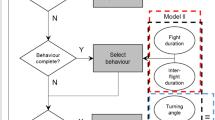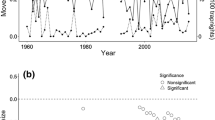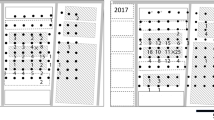Abstract
We provided an extensional method for diffusion equation models so far presented to cover cases where diffusion coefficients temporally change. We applied this method to data sampled from mark recapture surveys to estimate the natural mean dispersal distance and diffusion coefficients of terrestrial firefly larvae, Luciola parvula Kiesenwetter (Coleoptera: Lampyridae: Luciolinae). The surveys were conducted twice (December 2009 and March–April 2010) on a Cryptomeria plantation where 100 traps were placed in a lattice pattern at 30 cm intervals (10 × 10). Marked larvae were released at the center of the lattice, and the number of recaptures was recorded. Larval dispersal became remarkably active on the first night with rainfall as well as on the following day. The estimated natural mean dispersal distances (±SE) were 100.7 (±18.4) cm (December) and 245.4 (±700.0) cm (March–April). The diffusion coefficients just after rainfall were estimated to increase by 14.2 (±6.1) times (December) and 106.0 (±55.9) times (March–April) (±SE). Larvae were expected to disperse no further from where their eggs were laid. Most of their dispersing activity took place just after rainfall. Our extensional method was able to effectively illustrate that larval dispersal was affected by rainfall. This method can be usefully applied to any other species that disperses according to environmental conditions.



Similar content being viewed by others
References
Arakaki N, Nagayama A, Kobayashi A, Kishita M, Sadoyama Y, Mougi N, Kawamura F, Wakamura S, Yamamura K (2008a) Control of the sugarcane click beetle Melanotus okinawensis Ohira (Coleoptera : Elateridae) by mass trapping using synthetic sex pheromone on Ikei Island, Okinawa, Japan. Appl Entomol Zool 43:37–47. doi:10.1303/aez.2008.37
Arakaki N, Nagayama A, Kobayashi A, Tarora K, Kishita M, Sadoyama Y, Mougi N, Kijima K, Suzuki Y, Akino T, Yasui H, Fukaya M, Yasuda T, Wakamura S, Yamamura K (2008b) Estimation of abundance and dispersal distance of the sugarcane click beetle Melanotus sakishimensis Ohira (Coleoptera: Elateridae) on Kurima Island, Okinawa, by mark-recapture experiments. Appl Entomol Zool 43:409–419. doi:10.1303/aez.2008.409
Arakaki N, Hokama Y, Yamamura K (2010) Estimation of the dispersal ability of Melanotus okinawensis (Coleoptera: Elateridae) larvae in soil. Appl Entomol Zool 45:297–302. doi:10.1303/aez.2010.297
Baars MA (1979) Patterns of movement of radioactive carabid beetles. Oecologia 44:125–140. doi:10.1007/bf00346411
Barbaresi S, Santini G, Tricarico E, Gherardi F (2004) Ranging behaviour of the invasive crayfish, Procambarus clarkii (Girard). J Nat Hist 38:2821–2832. doi:10.1080/00222930410001663308
Brouwers NC, Newton AC (2010) The influence of barriers and orientation on the dispersal ability of wood cricket (Nemobius sylvestris) (Orthoptera: Gryllidae). J Insect Conserv 14:313–317. doi:10.1007/s10841-009-9256-8
Buck J, Case J (2002) Physiological links in firefly flash code evolution. J Insect Behav 15:51–68. doi:10.1023/a:1014480028731
Clobert J, Baguette M, Benton TG, Bullock JM (2012) Dispersal ecology and evolution. Oxford University Press, Oxford
Committee of the red data book Chiba (2011) The important species for protection in Chiba Prefecture: Red data book Chiba 2011 —Animals—. Nature conservation division, environmental and community affairs department, Chiba prefectural government, Chiba
Fu X, Vencl FV, Nobuyoshi O, Meyer-Rochow VB, Lei C, Zhang Z (2007) Structure and function of the eversible glands of the aquatic firefly Luciola leii (Coleoptera : Lampyridae). Chemoecology 17:117–124. doi:10.1007/s00049-007-0370-3
Fu X, Meyer-Rochow VB, Tyler J, Suzuki H, De Cock R (2009) Structure and function of the eversible organs of several genera of larval firefly (Coleoptera: Lampyridae). Chemoecology 19:155–168. doi:10.1007/s00049-009-0016-8
Kakehashi K, Kuranishi RB, Kamata N (2013) Environmental factors affecting spatial distribution and activity of firefly larvae Luciola parvula (Coleoptera: Lampyridae: Luciolinae): high activity under rich soil moisture. Jpn J Conserv Ecol pp 45–54. (in Japanese with Englsih summary)
Kawashima I, Suzuki H, Sato M (2003) A check-list of Japanese fireflies (Coleoptera, Lampyridae and Rhagophthalmidae). Jpn J Syst Entomol 9:241–261
Kurashima A (2002) The climate of Japan. Kokon-shoin, Tokyo (in Japanese, a title is a tentative translation by authors of this article)
Lewis SM, Cratsley CK (2008) Flash signal evolution, mate choice, and predation in fireflies. Annu Rev Entomol 53:293–321. doi:10.1146/annurev.ento.53.103106.093346
Ohba N (2004a) Flash communication systems of Japanese fireflies. Integr Comp Biol 44:225–233. doi:10.1093/icb/44.3.225
Ohba N (2004b) Mystery of flickering fireflies (Hotaru tenmetsu no fushigi). Yokosuka City Museum, Yokosuka (in Japanese, a title is a tentative translation by authors of this article)
Ohba N (2009) Mystery of fireflies (Hotaru no fushigi). Doubutsu-sha, Tokyo (in Japanese, a title is a tentative translation by authors of this article)
Ohba N (2010) Biological study and preservation of the firefly, Luciola parvula in progress. Nat Insects 45:2–6 (in Japanese)
Schwarzkopf L, Alford RA (2002) Nomadic movement in tropical toads. Oikos 96:492–506. doi:10.1034/j.1600-0706.2002.960311.x
Traugott M (2002) Dispersal power, home range and habitat preference of cantharid larvae (Coleoptera : Cantharidae) in arable land. Eur J Soil Biol 38:79–83. doi:10.1016/s1164-5563(01)01131-1
Turchin P (1998) Quantitative analysis of movement. Sinauer, Sunderland
Van Dyck H, Baguette M (2005) Dispersal behaviour in fragmented landscapes: routine or special movements? Basic Appl Ecol 6:535–545. doi:10.1016/j.baae.2005.03.005
Wells GP (1944) The water relations of snails and slugs III. Factors determining activity in Helix pomatia L. J Exp Biol 20:79–87
Wolfram Research, Inc. (2010) Mathematica. Version 8.0 Wolfram Research, Inc., Champaign, Illinois
Yamamura K, Kishita M, Arakaki N, Kawamura F, Sadoyama Y (2003) Estimation of dispersal distance by mark-recapture experiments using traps: correction of bias caused by the artificial removal by traps. Popul Ecol 45:149–155. doi:10.1007/s10144-003-0152-x
Yasuoka T (2010) Food resource, starvation tolerance and natural enemies of the Japanese terrestrial firefly, Luciola parvula (Coleoptera: Lampyridae). Nat Insects 45:15–17 (in Japanese)
Acknowledgments
We thank Mr. Yagi T of the Museum of Nature and Human Activities, Hyogo and Mr. Yasuoka T, former doctoral students of Kobe University, for their useful information on the bait trapping method of larvae capture. We thank Mr. Suzuki M, the ward mayor of the Uchiura district, and staff of Uchiurayama Kenmin no Mori, Chiba for their allowance of land use for our research. We would also like to thank faculty members and students of the Education and Research Center, the University of Tokyo Forest for their support.
Author information
Authors and Affiliations
Corresponding author
Appendix: estimating parameters in Eq. (4)
Appendix: estimating parameters in Eq. (4)
In this appendix, we briefly explain the procedure of estimating parameters in Eq. (4) by the maximum likelihood method.
The mean number of surviving individuals up to time t, S(t), is expressed by Eq. (4) as given again below:
Hence, the number of individuals captured in the ith day, i.e., captured number of individuals between t i−1 and t i , is calculated as follows:
We assume here that the observed number of captured individuals on each day follow a Poisson distribution with the mean value described by the above Eq. If the observed number is n i in day i, the probability that this takes place is described as follows:
Please note here that we have parameters λ D , δ D , and d 2. Then we obtain the log likelihood function to be maximized as follows:
The maximum likelihood estimates of parameter values, λ D , δ D and d 2, are obtained as such. Please note that we put d 1 = 1 and d 2 = D 2/D 1 to adjust the redundancy of parameters.
About this article
Cite this article
Kakehashi, K., Kuranishi, R.B. & Kamata, N. Estimation of dispersal ability responding to environmental conditions: larval dispersal of the flightless firefly, Luciola parvula (Coleoptera: Lampyridae). Ecol Res 29, 779–787 (2014). https://doi.org/10.1007/s11284-014-1156-z
Received:
Accepted:
Published:
Issue Date:
DOI: https://doi.org/10.1007/s11284-014-1156-z




